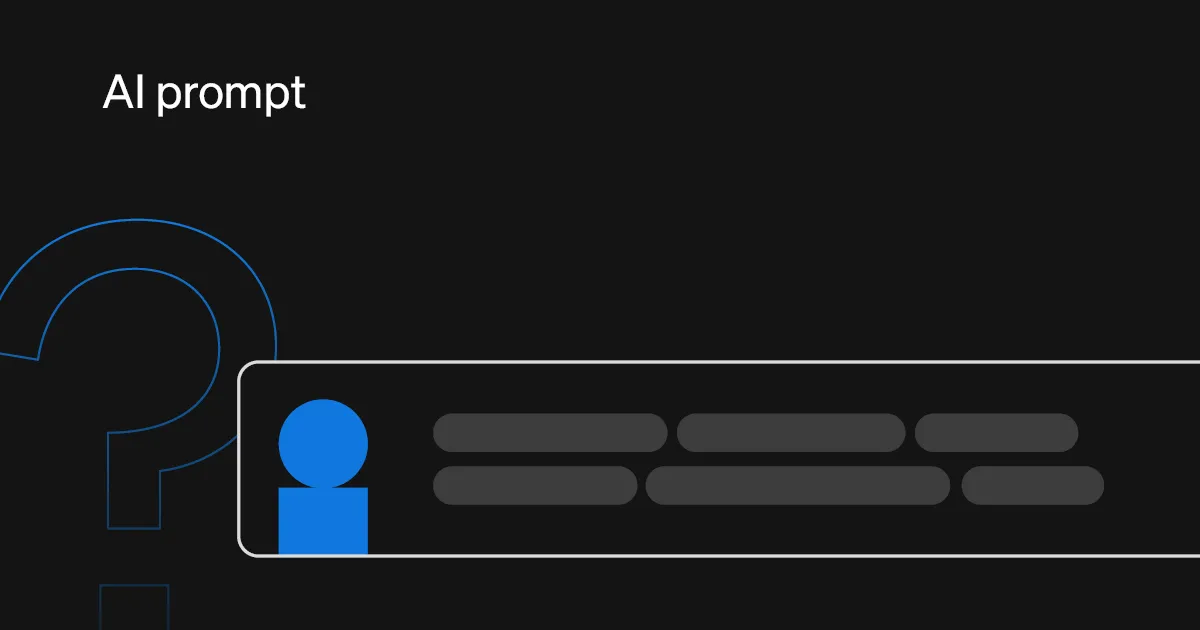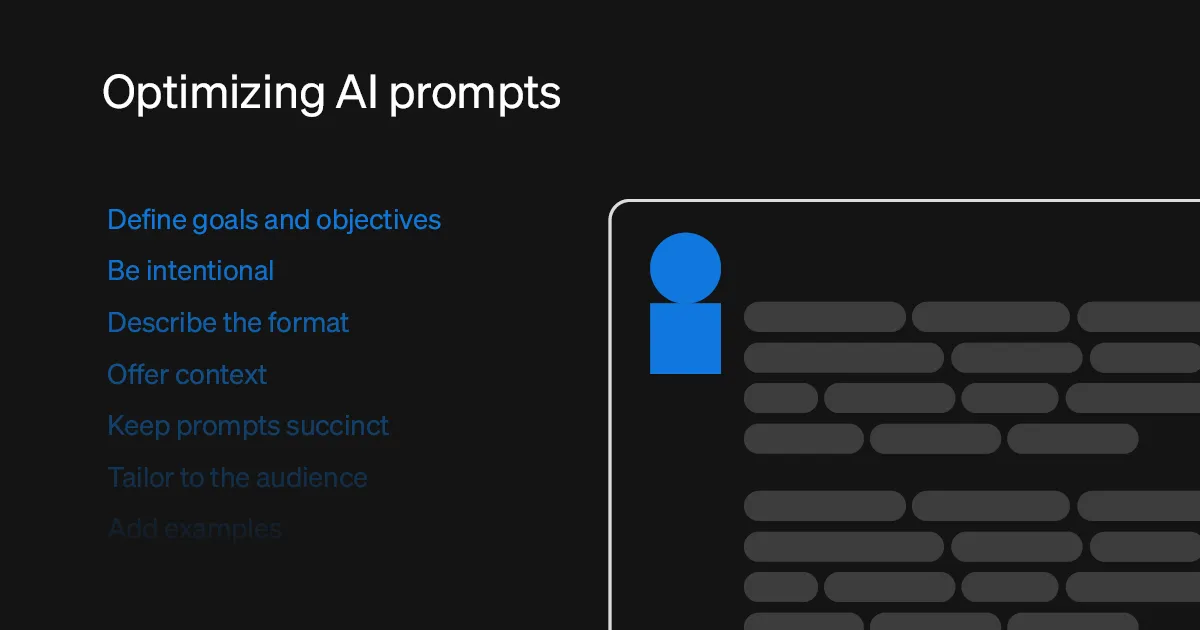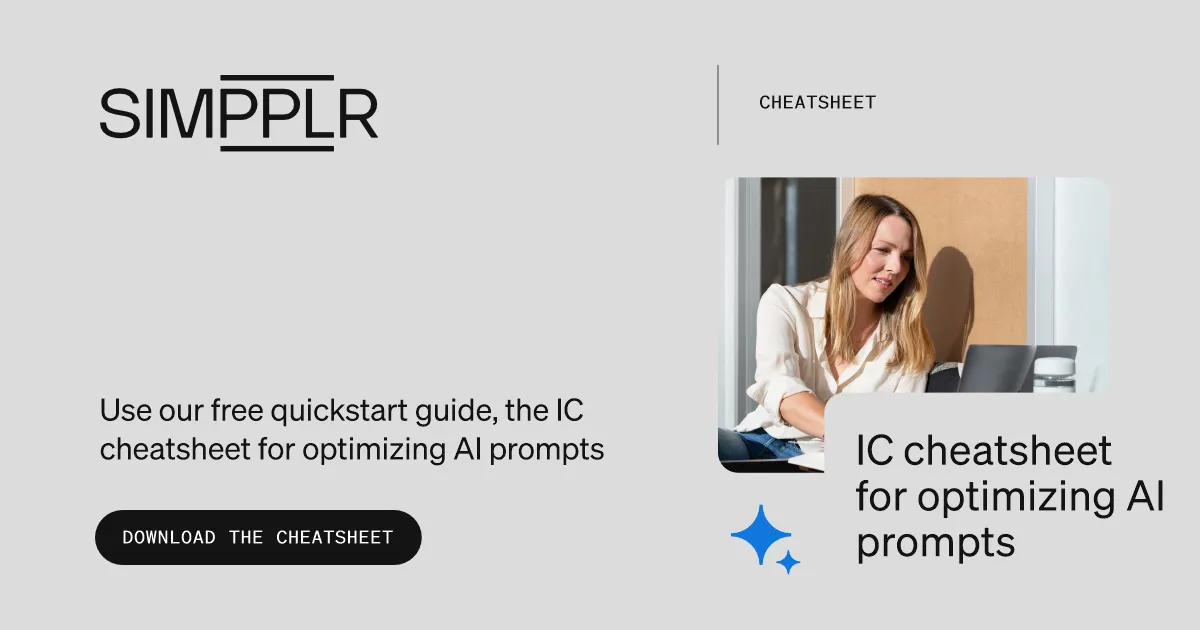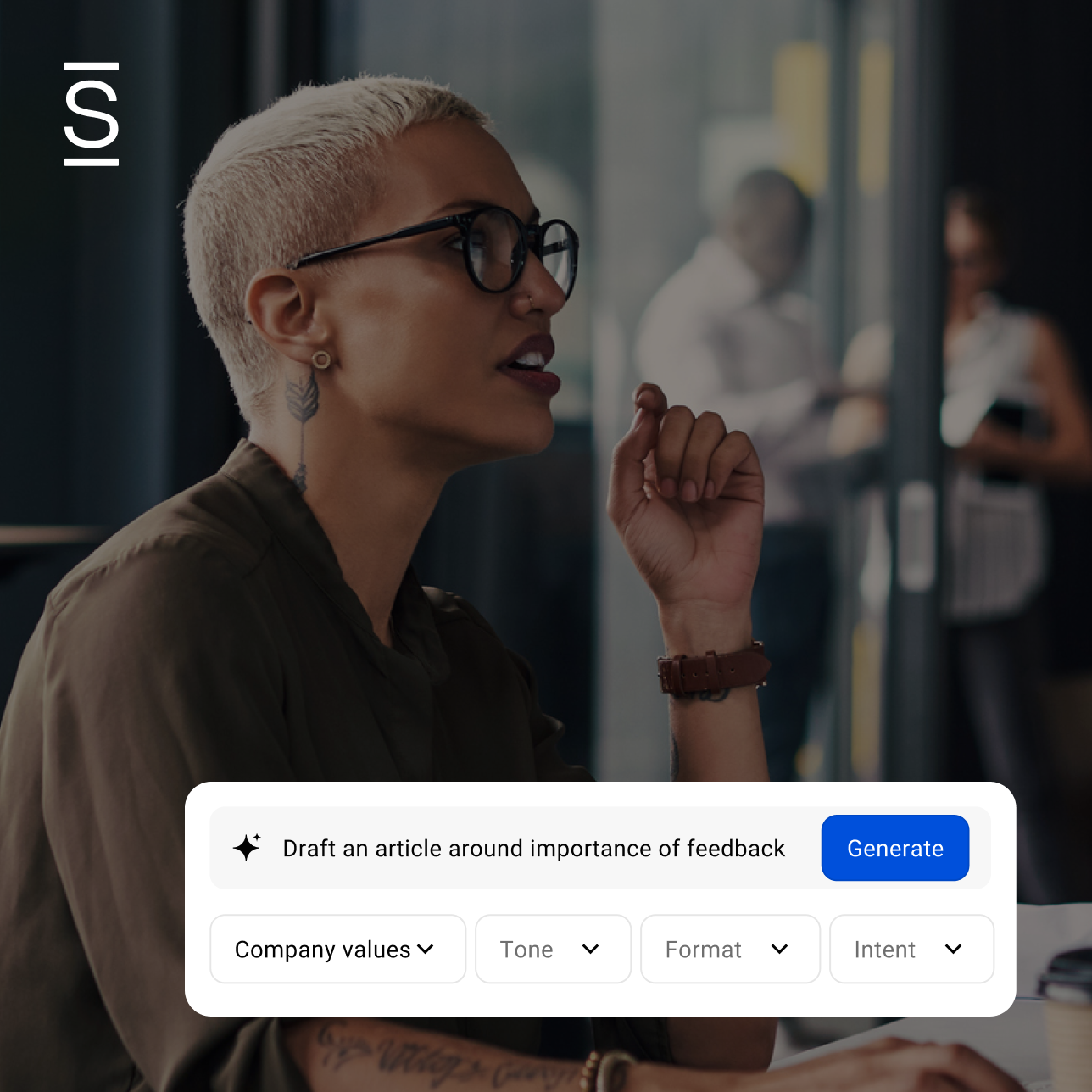This article was originally published on Jan. 19, 2024, and was updated on Feb. 26, 2024.
Looking to streamline your internal comms workflow without sacrificing the quality of your output? Optimized AI prompts might be the answer.
AI prompts are important techniques for internal communications teams to understand and use as artificial intelligence systems become more integrated into our lives and workplaces. A recent study from Forbes Advisor found that 42% of business owners expect AI to streamline job processes — like internal communications.
You’re in the right place to learn all about optimizing AI prompts for internal communications. We look at what AI prompts are, how they improve productivity, and the challenges that you might face while working with AI prompts.
From the internal comms perspective, we also explore several strategies for optimizing AI prompts with use cases and examples of familiar IC tasks that might benefit from AI prompting.
Table of contents: Guide to optimized AI prompts for internal communications
- Understanding AI prompts
- Benefits and challenges of using optimized AI prompts for IC
- Strategies for optimizing AI prompts
- Use cases for optimized AI prompts
- Key takeaways and next steps
- Free IC cheatsheet for optimizing prompts
Let’s dive in!
Understanding AI prompts
Before we can optimize AI prompts, we first need to understand them, their purpose and how they can be refined to produce different outputs.
What are AI prompts?
An “AI prompt” refers to an input that is given to an artificial intelligence model to trigger a specific activity or output. In other words, it’s the guiding language (direction) for the AI to execute a desired function.
AI prompt example: “Create a draft for our monthly internal newsletter, highlighting recent news, upcoming events and new hires.”
The example prompt above demonstrates a directive you might provide AI to have it create a newsletter for your company.
Why are AI prompts important?
If your goal is to get the best output from AI — and it should be — then your prompt is the most important part of the process.
AI prompts are your instructions and the clearer and more specific those instructions are, the better the results.
Direct prompts with relevant context increase the likelihood of AI’s output aligning with your expectations.
Example of bad AI prompt: “Write a blog article about our recent changes.”
Example of better AI prompt: “Write a blog article for our employees describing the new work-from-home policy that is outlined below…”
The first AI prompt lacks clarity on the audience and the specific changes made, which can result in an output that is too general or inaccurate. The second prompt provides more detail and reduces ambiguity to help produce an article closer to what you want. But it’s still not as highly optimized as it could be. Intrigued? Read on.
What does optimizing an AI prompt mean?

Optimizing an AI prompt means enhancing the prompt to produce the best, most effective AI response. It’s an iterative process that involves taking a single goal (e.g., writing an internal blog post about the new work-from-home policy) and modifying the prompt until you get the best response.
We use “best” loosely because there is no perfectly optimized prompt. There are endless ways to phrase a prompt, and additional context or direction can always be added — so it’s important to balance time and effort with expected results.
AI is meant to streamline tasks and reduce bandwidth — don’t fall into an over-optimization loop.
AI prompts, functions and software are not created equal, so it’s vital to also understand exactly how to tailor each prompt to produce the desired output for your specific AI tool. An adjustment as simple as one word or a short phrase can produce a more desired output. This process will take time and patience — but it’s well worth the effort.
Learn more about using AI in communications strategy
Benefits and challenges of using optimized AI prompts for internal communications
Internal communications teams are using AI prompts in many different ways to free up time and streamline repetitive tasks. From summarizing meeting notes and creating content calendars to analyzing employee surveys and drafting newsletters, the opportunities for using optimized AI prompts are endless.
Let’s take a closer look at some of the benefits of using optimized AI prompts for internal communications — along with some challenges.
Benefits of optimized AI prompts
Internal communications practitioners can use optimized AI prompts to increase productivity and work more efficiently. Below are a few of the most common benefits you might expect to see.
Improved communication efficiencies
An optimized AI prompt produces the most desired output using speed and accuracy unmatched by a human. This improved efficiency doesn’t just save you time, it helps communicate important information to your team faster.
Better resource allocation
By leveraging optimized AI prompts effectively, the IC team and other resources can focus on more strategic work and challenging problems.
More consistency in communication
Optimized AI prompts can ensure consistency in communications across all departments and levels within an organization — helping to create a cohesive culture with equitable distribution of information.
Makes scaling easier
Ultimately, one of the main reasons internal comms teams are turning to AI for support is that it supports scalability. Optimized AI prompts give organizations the ability to scale internal communications without sacrificing quality or requiring a substantial investment.
Challenges of optimized AI prompts
Optimized AI prompts offer internal communications departments many benefits, but they also bring challenges and obstacles that you must learn to overcome. Here are some of the most common challenges you might face:
Managing change
Moving to an AI-based solution for IC tasks requires changing systems, processes and responsibilities. Effective change management is not easy and usually comes with growing pains. From learning new technologies and workflows to managing employees whose roles have shifted, you’ll need to proactively address many changes.
Giving unclear instructions
If your AI prompts are not optimized enough, the results could be incomplete and ineffective. AI tools depend on context and clear prompts, so any input issues will lead to subpar output that could cause confusion or misinformation.
Losing the humanity
While an AI output may nail your desired theme or message, it may fail to convey more complex or nuanced ideas — it’s not human, after all. Internal communications requires tact and empathy which does not always translate well with AI.
Risking security and data protection
AI has access to sensitive and important company and personal information. This private information is always at risk of data breaches or potential hackers, so make sure you do your part to protect your data — and, if you’re using GenAI-powered writing assistance within your intranet software, that your intranet provider takes AI security seriously.
Explore finding equilibrium between enlightenment and doomsday with AI
Strategies for optimizing AI prompts

There are many types of internal communications content that you could create using AI prompts, so it’s key to approach each prompt strategically. Below are some techniques to help you optimize AI prompts more effectively.
Define goals and objectives
Before you start prompting, take a second to clearly define your goals and objectives. This perspective should guide your prompts and will be useful in measuring the AI’s output.
Be intentional
Specificity is the key to optimizing AI prompts. The more freedom you give an AI model, the more likely it is to stray off course. Use concise and clear language to reduce ambiguity.
Describe the format
Internal communications content can come in a variety of formats (newsletters, articles, policies, emails, etc.). Clearly defining the format and structure of content needed will offer more direction to the AI model.
Offer context
Most AI models will draw from external sources if you do not provide it with the context needed to answer your prompt. So, if you’re prompting AI to write an FAQ for new hires, you need to give it adequate resources to do so. The more relevant context you can provide, the better.
Keep prompts succinct
While the context and background needed for your prompts can be lengthy, the “ask” should be as short and direct as possible. Use simple sentences and clear language in your prompt to avoid confusion.
Tailor to the audience
If you are targeting specific employees or departments, include that in your prompt. Communication is most effective when it’s targeted to the audience receiving it, so keep that in mind as you optimize AI prompts.
Add examples
One of the best ways to control AI’s response is to provide it with an example. Whether formatting, structure, style or voice, adding an example to your prompt can help AI replicate that example in its output.
Iterate the prompt
Optimizing AI prompts requires adaptation and refinement. Don’t be shy about making changes to your prompt and monitoring the results of those changes until you get an output that you are satisfied with. Use this insight to create a framework for future prompts.
Use cases for optimized AI prompts
Alright, we get it — it’s important to optimize AI prompts.
But what does that look like in the context of internal communications content? How can we use AI prompts and what do we need to do to make sure those prompts are effective?
Let’s look at three use cases for internal comms with AI prompt examples and potential ways to optimize the prompts.
Company policy announcements
Writing an article about a new company policy to be published on the organization’s intranet is a common task for internal communications teams. For example, let’s say the IC team needs to write a 500-word blog post about a new sales commission policy. While it could take someone two to three hours to review the new policy and write an article, AI could do it in seconds — with an optimized prompt.
Example AI prompt:“Draft an article outlining the new company policy below. [new policy]”
This AI prompt would certainly get you a summary article of the new policy, but there may be ways to optimize it for an even better result. Consider the questions below and whether they could be used to improve the prompt:
- Is the new policy for a specific department or type of employee? (e.g., part-time employees, sales team, etc.)
- Do you have internal brand guidelines for this type of content? (e.g., content length, tone, style, etc.)
- Are there additional resources that would help? (e.g., it’s an update to an existing policy: you would also include the original policy to highlight the changes)
- Do you have an example article to guide the response?
Optimized AI prompt: “Draft an article for our sales department about the recent changes made in our commission policy. Use the old and new policies below. Follow our brand guidelines below. Respond in a format, style and voice that matches the example article below. [resources – labeled]”
Employee surveys
Internal comms keeps a pulse on the employees within the organization. One of the ways they do that is through employee sentiment and engagement surveys. This task usually involves creating a survey, sharing it with employees, analyzing the results, and summarizing your findings. While some AI tools like Employee Listening from Simpplr can offer continuous, real-time insights — you may want to work with AI prompts to accomplish some of these steps.
For instance, use an AI tool to analyze the survey results and draft a summary of the findings.
Example AI prompt: “Analyze and summarize the key findings from the employee engagement survey below [employee survey results]”
This AI prompt would offer a summary of the survey results, but there may be ways to optimize it more. Consider the following questions and whether they could help enhance the prompt:
- Were there targeted areas of focus for the survey? (e.g., job satisfaction, work-life balance, management feedback, etc.)
- Who received this survey? (e.g., specific employees, years at the company, departments, etc.)
- Are there additional resources that would help? (e.g, last results of the same survey, incident reports, etc.)
- How do you want the response formatted? (e.g.,. graphically, text, bulleted, etc.)
Optimized AI prompt: “Analyze and summarize the results of a recent employee engagement survey focusing on work-life balance. Compare the results with last quarter’s survey looking for trends. Break down your response by department and seniority. Include graphs and charts in your response. Based on these findings, provide 3-5 actionable items to improve work-life balance. [resources – labeled]”
Meeting/event invitations
Internal comms teams are routinely tasked with creating and sending out invites to upcoming events and meetings. While seemingly trivial, this activity can be cumbersome and time-consuming. Additionally, the invitation itself provides a lot of important information about the event (when, where, why) and can play a crucial role in attendance — good or bad.
Let’s say the marketing department has planned a brainstorming session focused on their new ad campaign. Brand guidelines, the meeting agenda and event details are available to include in the AI prompt.
Example AI prompt: “Create an email invitation for our upcoming team meeting. [meeting details]”
This AI prompt would produce a basic email invitation for the meeting, but there may be some techniques to optimize that prompt to make it more engaging and informative. Consider the following questions and whether they could be used to improve the prompt:
- Who should attend the meeting? (e.g., department, employee types, everyone, etc.)
- What is the purpose of the meeting? (e.g., training, brainstorming, team-building, etc.)
- Should attendees come prepared for or with anything? (e.g., pre-meeting questions, training material, etc.)
- Do they need to RSVP for the meeting?
Optimized AI prompt: “Create a detailed email invitation for our marketing department about an upcoming brainstorming session for our new advertising campaign. The tone should be informal and engaging, following the brand guidelines below. Include a brief agenda and other important event details found below. Ask attendees to bring ideas to discuss. Follow our example meeting invitation below. Provide RSVP instructions. [resources – labeled]”
Discover how AI can help create a modern employee experience
Key takeaways and recommended next steps
AI can have a significant impact on the productivity of an internal communications team which, in turn, drives significant growth of an organization. Understanding the role of artificial intelligence is key, but more importantly, you need a firm grasp on how you can best leverage AI to meet your unique goals — which often comes down to your AI prompt.
A strong alignment between your goals and AI prompts will lead to better results.
This alignment is achieved by optimizing AI prompts through iteration, refinement and testing. As you work through your prompts, be mindful of the challenges we covered above.
If you’re interested in learning how artificial intelligence can work more intuitively with your internal communications team, you’ll want to see Simpplr’s AI-powered intranet. Request a demo to see how Simpplr leverages the power of responsible AI to enhance and elevate the employee experience and boost productivity.
IC cheatsheet for optimizing prompts
Download our free IC cheatsheet for optimizing AI prompts to jumpstart your journey to creating the most effective prompts for common IC workflows.
















